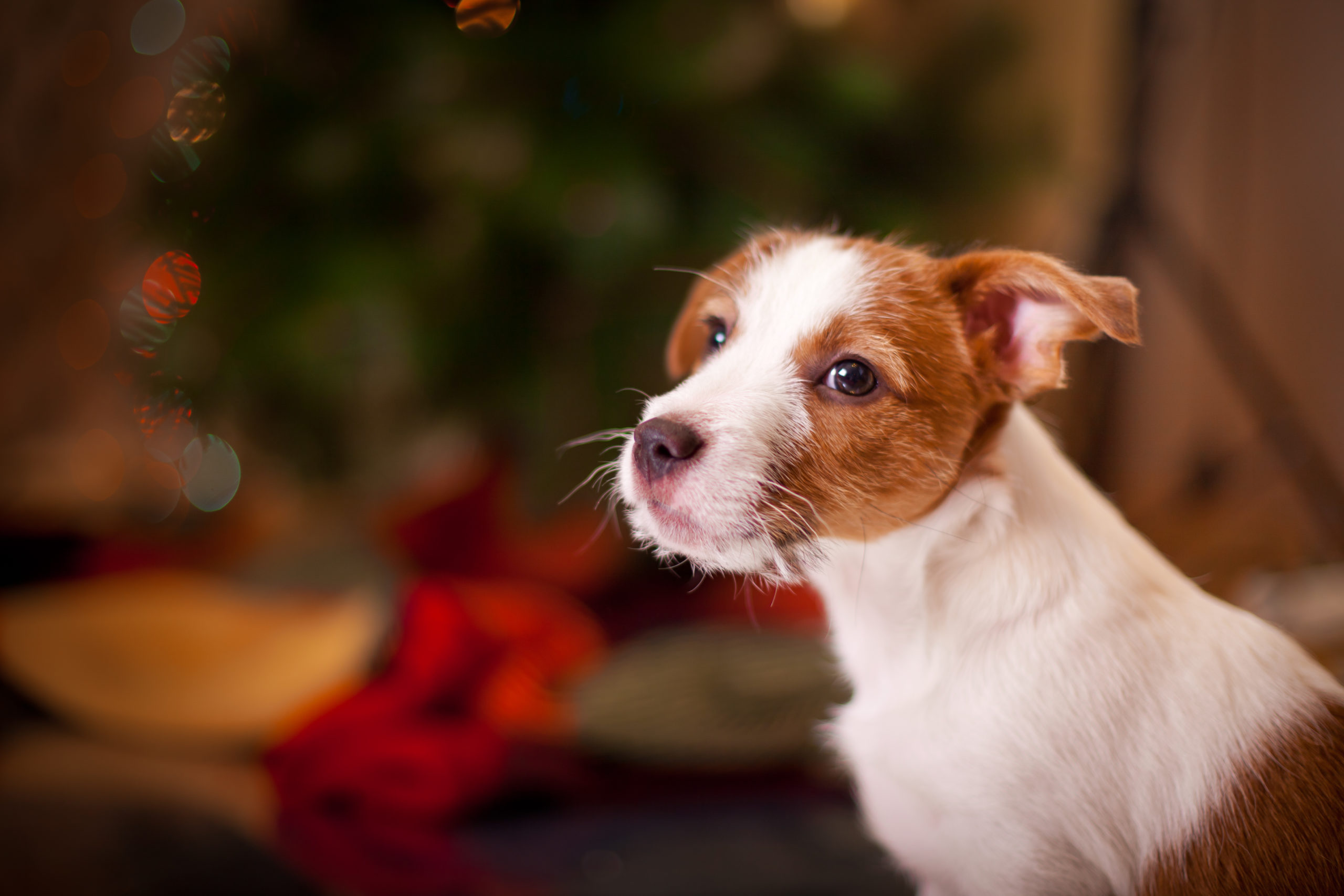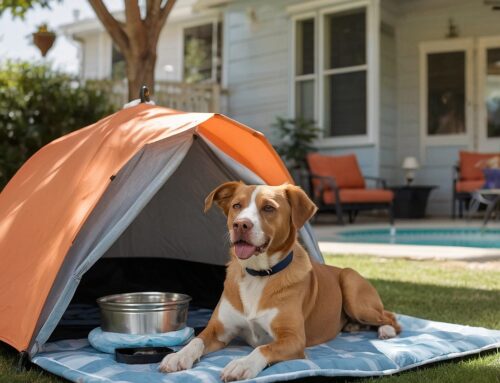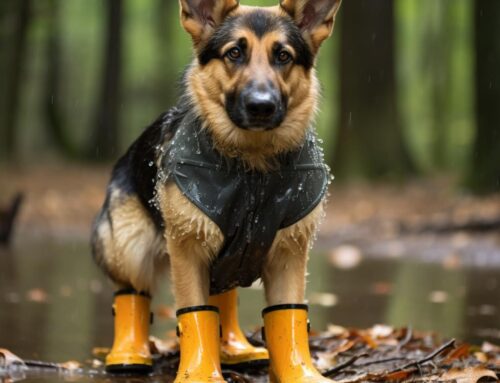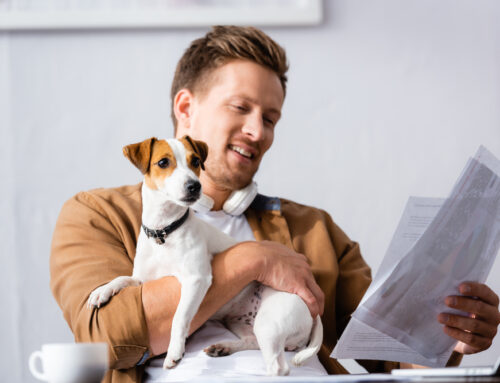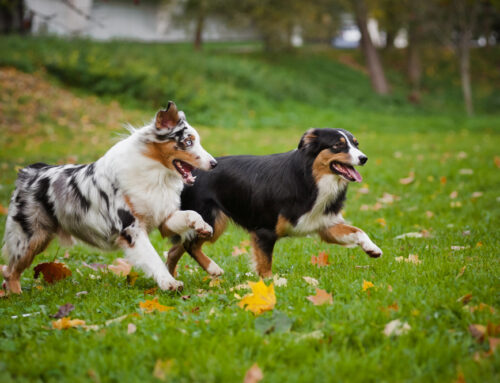‘Tis indeed the season to be jolly, and festivities abound everywhere. But it’s also the season to take extra care of our most precious canine companions to be sure they stay warm, safe, and healthy amid all the frivolity.
Holiday Decorations
Regardless of what you do or don’t celebrate, somewhere along the line, you and your pet are bound to meet up with some holiday decorations. Though beautiful, they can pose many dangers for your dog.
Christmas Tree
The lights, the ornaments, the candy canes – all may be irresistibly enticing to your dog, but peril potentially lurks with each glorious item.
- Christmas tree: And so, your dog says to itself, what a cool thing it would be to climb that tree! Besides some serious “leave it” training, if you have a tree, be sure it is securely anchored and that you never leave your dog alone with it.
- Tree water: If you have a real tree, be sure not to put any additives in the water at its base.
- Ornaments: All those beautiful glass ornaments on the tree add up to real danger. Broken bulbs mean cuts and potential intestinal blockages if swallowed.
- Lights: Electric lights are dazzling and potentially tempting for your dog to further explore. But, burns, or worse, are the hazards of your pet’s unwitting foray into playing with the tree lights. The safest approach is to plug your lights into a three-prong, grounded extension cord.
- Tinsel: You might want to forgo using tinsel on your tree as it is extremely dangerous if your dog decides to sample any. First, it is almost impossible to chew, and second, if swallowed, it can wrap itself around your pet’s intestines and organs, causing a medical emergency visit to the veterinarian.
Plants
Perhaps you enjoy dressing up your home with plants and flowers during the holidays and wintertime. You can find a complete list of toxic plants at the ASPCA website, but for the shortlist, avoid amaryllis, mistletoe, balsam, pine, cedar, and holly as they can cause gastrointestinal problems, or even poison your dog. Unlike what most people think, the poinsettia is not poisonous to dogs, but it can cause irritation to your dog’s mouth or stomach if consumed in large quantities.
Candles
One of the safest inventions around is flameless candles. They create the same dreamy holiday atmosphere as regular candles without the possibility of being knocked over by little paws, little hands, or big hands. In other words, if you do have regular candles, be sure to never leave them lit when you are not right there to monitor and prevent any potential catastrophes, but do consider adding the flameless variety to enhance your holiday atmosphere.
Outdoor Decorations
Nowadays, the plethora of outdoor holiday decorations ranges from huge, inflatable Santas and snowmen to outdoor lights, to miscellaneous and sometimes dangerous garlands and adornments. Your dog may be terrified by the huge bobbing blow-up creatures and do all the things dogs do when they are frightened: run away, tremble, and develop phobias that can manifest in any number of ways in the future. Do minimize his exposure to these outdoor decorations.
Gift Wrap and Ribbon
Your canine tennis ball lover may mistake balled-up wrapping paper as irresistible and ingest a few bites, especially if it’s of the shiny variety. Choking is a definite hazard, as well, and ribbon can find its way into your pet’s intestines in the same way as tinsel.
Dangers of Food
Whether hosting a party, or staying home and feasting, when your back is turned, or even if it isn’t, dogs become seriously wild over all the goodies that are part of holiday gatherings. Any food devoured in large quantities can cause stomach upset, or worse. But the following foods are especially toxic and, in some cases, can even poison your pet.
- Chocolate: Despite our love for this ultimate candy treat, it is especially dangerous for your dog. The darker the chocolate, the more toxic it is. Some of the symptoms of chocolate ingestion include diarrhea, vomiting, hyper-ness, tremors, and even seizures.
- Bones: Poultry bones break apart into splinters when chomped on by dogs. These splinters cut mouths and can cause serious damage to your dog’s digestive tract.
- Fat: Gravy and other foods that are high in fat content can result in pancreatitis, a life-threatening condition that requires immediate veterinary care.
- Nuts: Besides being a potential choking hazard, some nuts are toxic, and all nuts can result in intestinal obstructions. Almonds and pistachio nuts are especially toxic to dogs.
Guests
It’s possible that you may be having guests over the holiday season. No matter how your dog reacts to company, you need to take special precautions to keep everyone safe. One of the more frightening prospects is that your dog could run out the door when you open it to let the company in. Here’s how you can avoid such a tragic scenario:
- Put your dog in a nice, warm, cozy room where he can stay safe. Give him a special treat, and even consider leaving the TV on or soft music playing.
- If a guest asks to bring a dog along, you might want to discourage it. Even if your dog is tucked safely away, the two dogs will smell each other. If the two dogs do come face-to-face, you’re left going through introductions that could be unpleasant, depending on the dogs.
- If your dog is left outside, be watchful of all doorways leading to the outside.
- Clear the dinner and coffee table of all the snacks and food, especially when no one is around.
- Cover and secure the trash can to prevent little paws from being able to open it.
What’s Too Cold?
The answer to this question is the ultimate “it depends.” Your dog’s coat, age, weight, and the temperature outside, all add up to answering the question about your dog. The following are tips for what you can do to keep your dog warm during our cooler winter months.
- Dress right: A doggy coat is a great investment for your pooch. If your dog has a longer coat – like a Husky or Collie — look for a jacket that is thinner. If he has a thin coat – like a whippet or Boston Terrier – he needs some insulation to keep him warm. Since rain is an issue here in the winter, you might want to invest in a doggy raincoat because a wet dog is a cold dog.
- Booties: Overkill? Not if you’re hiking in areas where there’s ice and snow. However, here in our area, booties may not be necessary unless you’re walking on rough surfaces or if it’s raining.
- Clean and dry paws: After a walk, wash your dog’s feet and dry them completely. Apply some moisturizer after, such as beeswax or Shea butter.
- Shorter outside times: Especially if the temperature has dropped significantly, consider making your outside time shorter.
- Long coat: If you have a dog who has a coat that needs grooming, consider letting it grow for the winter months.
- Outdoor shelter: It’s never a good idea to leave a dog outside unattended, but if the need arises, make sure he has a well-insulated and dry area for protection.
- Calories: We all need a higher caloric intake to stay warm in the winter. Talk to your vet or veterinary nutritionist for advice on the best way to give your dog the extra energy necessary for winter. Also, make sure there is always fresh water available for him.
How to Tell If Your Dog is Cold
There’s no doubt that your dog will tell you when he’s cold. Watch out for any of these signs:
- Shivering
- Trembling
- Tucked tail
- Hunched back
- Splays and refuses to keep going
- Lifts paws off the ground
- Ears and nose icy cold
If your dog exhibits any of these, it’s time to head for home and a cup of hot chocolate for you and a special treat for your pup.



